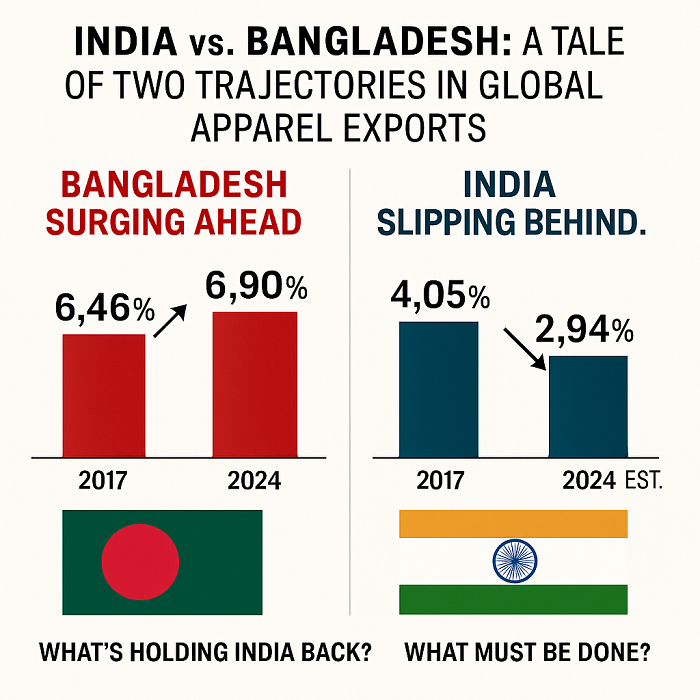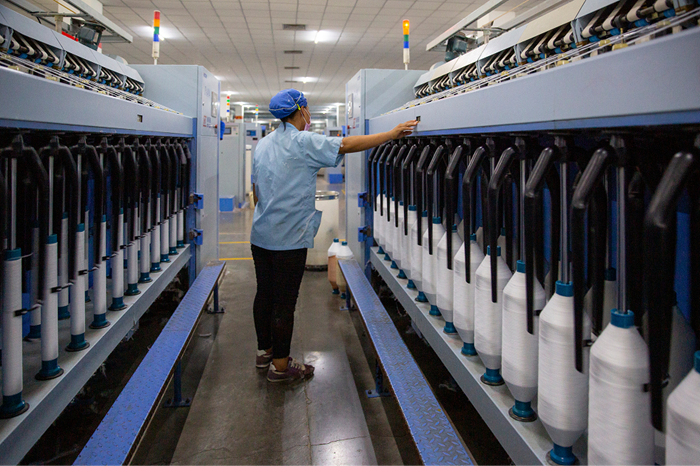
The global apparel market is a dynamic arena, and a close examination of the data reveals a compelling story of competition and contrasting trends between two South Asian manufacturing powerhouses: Bangladesh and India. While both nations are significant players, their trajectories and market strategies appear to differ, leading to distinct outcomes in recent years.
Bangladesh: A dominant and growing force
Bangladesh has firmly established itself as a global leader in apparel exports, consistently demonstrating a strong performance and an upward trajectory in both value and market share. As per the "World Apparel Market" table, Bangladesh's apparel export value has seen substantial growth, particularly in 2021 and 2022. From $28.07 billion in 2020 (a dip likely due to the pandemic), it rebounded strongly to $34.20 billion in 2021 and $45.35 billion in 2022, reaching an estimated $38.48 billion in 2024. This growth is reflected in its burgeoning market share, which rose from 6.26% in 2020 to an impressive 7.87% in 2022, estimated at 6.90% in 2024.
The "Bangladesh's RMG Export World" data further illuminates the scale and breadth of Bangladesh's export operations. The European Union remains the primary market, with significant export values across both woven and knit categories. Germany, Spain, France, and Italy are key destinations within the EU. Outside the EU, the USA stands out as a crucial market, alongside Canada and Japan. The detailed breakdown by product type (woven vs. knit) also highlights the country's diversified production capabilities within the apparel sector. The "Total" column for 2023-24 (July-June) projects a massive export value of $39.346.97 million (approximately $39.35 billion), underscoring the sheer volume of their apparel trade.
India: A struggling giant with untapped potential
In contrast to Bangladesh's consistent growth, India's performance in the global apparel market, as depicted in the "World Apparel Market" table, presents a more challenging picture. While India's export value did see an increase from $12.97 billion in 2020 to $16.15 billion in 2021 and $17.71 billion in 2022, its market share has shown a concerning decline. From 4.05% in 2017, it steadily decreased to 2.95% in 2023 and is estimated to be 2.94% in 2024. This indicates that despite an increase in absolute export value, India is losing ground relative to the overall growth of the global apparel market. The "Growth in 2024" for India is projected at 6.50%, which is positive but significantly lower than some of its competitors like Cambodia (24.19%) and Pakistan (21.44%).
The reasons for this trend are complex. A declining market share suggests issues such as lack of favourable FTAs, competitiveness in pricing, efficiency in production, or perhaps a slower adaptation to changing global fashion trends and supply chain demands compared to nimble competitors.
Key trends and comparative analysis
Here's a data table summarizing and comparing the key trends:
|
Metric |
Bangladesh (World Apparel Market) |
India (World Apparel Market) |
|
2017 Export Value |
$29.34 Billion |
$18.41 Billion |
|
2024 (Est.) Export Value |
$38.48 Billion |
$16.36 Billion |
|
2017 Market Share |
6.46% |
4.05% |
|
2024 (Est.) Market Share |
6.90% |
2.94% |
|
Trend in Market Share |
Generally increasing (with fluctuations), strong rebound |
Consistently decreasing |
|
Growth in 2024 (Est.) |
0.21% (from 2023 to 2024) |
6.50% (from 2023 to 2024) |
|
Key Product Focus (Bangladesh RMG) |
Woven and Knit (diverse product range within apparel) |
- |
|
Dominant Markets (Bangladesh RMG) |
EU (Germany, Spain, France, Italy), USA, Canada, Japan |
- |
Observations and key trends:
● Market share divergence: The most striking trend is the clear divergence in market share. Bangladesh has gained significant ground, solidifying its position as a major global supplier, while India has lost a considerable portion of its market share, indicating a struggle to keep pace with global demand and competition.
● Resilience and recovery: Bangladesh demonstrated remarkable resilience post-2020 (pandemic year), with a strong rebound in export values. This suggests a robust and adaptable industry structure. India also saw a recovery in value, but not enough to offset its declining share.
● Scale of operations: The sheer volume of Bangladesh's projected exports for 2023-24 (nearly $40 billion) further highlights its substantial production capacity and global footprint.
● Geographic focus: Bangladesh's strong ties with the EU and USA are evident, indicating successful long-term strategic relationships with key import regions.
● Growth rate paradox: Interestingly, India's projected growth rate for 2024 (6.50%) is higher than Bangladesh's (0.21%). This could imply a slower growth rate for Bangladesh after a period of rapid expansion, or perhaps a more saturated market for their current product offerings. For India, this higher growth rate, if sustained and amplified, could potentially help in stemming the decline in market share in the future, but it will require consistent effort.
Bangladesh expanding force, India faces headwinds
Bangladesh is a highly successful and expanding force in the global apparel export market, capitalizing on its established infrastructure and strong buyer relationships. India, despite its significant manufacturing base, appears to be facing headwinds, evidenced by its shrinking market share. For India to reverse this trend, a deeper analysis of its competitive disadvantages and a strategic pivot towards higher value-added products, improved efficiency, and stronger market linkages will be crucial. Conversely, Bangladesh's continued success will depend on maintaining its cost-competitiveness, diversifying its product portfolio, and navigating evolving global trade dynamics.












